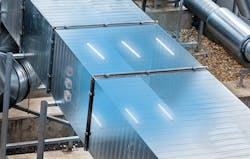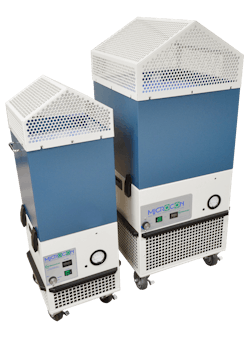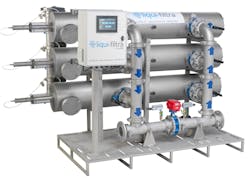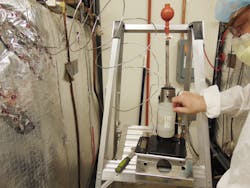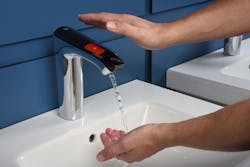It can certainly be said that water and air are vital within any facility, whether it be your home, office, school, church, or hospital.
But, wait just a few minutes before grouping in hospitals with the rest of these establishments which play central roles in our lives. Let’s remember what hospitals take on and provide everyday: the sick, the infected, the concerned, the morbid, the doctors, the caretakers, the staff…..
Or, how about the seemingly innumerable types of facilities within a hospital or health system, from the ER to the OR, from the laboratories to the pharmacies, from rehabilitation to administration…
The fact of the matter is that the wide variety of facilities and people that makeup the healthcare environment make it unique compared with other locations in our lives; indeed, its countless complexities and seemingly endless, potential issues make it far more dangerous than other environments.
And, just as in any other environment, the proper management of water and air lie at the very center of ensuring that a hospital retains highly efficient operations.
In fact, due to the ever-increasing resiliency and resistance of pathogens, air and water quality is more vital than ever, and hospitals are under more pressure than ever to ensure water and air quality.
Likewise, COVID-19 has undoubtedly triggered an increased focus on environmental quality within our health systems, and thus caused an uptick in seeking new, innovative, and combinative means to keep the air and water clean.
Use what works
Cleanliness may be next to Godliness, the adage says, but cleanliness really means healthiness when it comes to air, power, steam, and water quality necessary for patient care operations.
The combination of UV-C technologies and HEPA filtration systems have long become par for the course in our health facilities, as they are proven to be highly efficient at eliminating a wide range of pathogens and germs.
According to the CDC, UV-C radiation has effectively been used for decades to reduce the spread of bacteria, such as tuberculosis. For this reason, UVC lamps are often called “germicidal” lamps.1
Dr. Ashish Mathur, UVDI’s Vice President of Innovation and Technology, indicated germicidal Ultraviolet (UV) and high-efficiency filtration are proven technologies to combat the transmission of airborne and waterborne pathogens.
However, in consideration of the ever-increasing focus on infection prevention methodologies, how can a facility ensure that it is applying the best strategy to combat the spread of pathogens?
According to Dr. Mathur, “It starts with evaluating and selecting a proven technology. To do so, first review the technical guidance of leading Public Health organizations. For example, CDC, GSA, ASHRAE and IUVA include UV-C as a recommended mitigation step to reduce airborne transmission in commercial buildings. In addition, ensure the technology’s performance has been independently validated through accredited third-party testing and in peer-reviewed published studies. Last, due diligence on the manufacturer itself — pedigree, technical expertise and support capabilities, manufacturing location, sourcing and systems and current customer base – to name just a few criteria — is key to ensuring your are working with a capable and long-term partner in Public Health.”
UVDI’s portfolio includes proven solutions for both Air and Surface Disinfection, including the UVDI-360 Room Sanitizer, and the V-MAX advanced UV-C air disinfection technology.
Make HVACs reliable sources of cleanliness
While the practices (or lack thereof) of good hygiene and surface cleaning are well established as methods for preventing the spread of dangerous pathogens, nosocomial infections are potentially in the air all around at us (at any time) within a healthcare environment.
Thus, the movement of air particles via HVAC systems is a vital process within hospitals; HVAC systems that are not properly managed, maintained, and as needed, modified, make them one of the primary sources for microbial contamination within healthcare facilities.
According to Tony Julian, VP Business Development at RGF Environmental Group, “the HVAC system is one of the main sources for microbial contamination within healthcare facilities. There are a number of air quality standards which should be adhered to in order to guide facilities in managing effective HVAC systems, including ASHRAE 170, which provides key guidance on ventilation efficiency in healthcare settings.
The organization also provides Lucidium UV-C coil sanitation technologies, eliminating mold growth on HVAC coils and providing air purification to large facilities.
Julian emphasized that hospitals should “work with their facilities staff, HVAC contractors and engineers to identify problem areas, like mold on the HVAC coils or isolation room airflow. Then, select a reputable technology manufacturer to partner with over long term to ensure a reliable solution is delivered, realized (tested if necessary) and supported. Follow CDC, EPA and ASHRAE guidance for indoor air quality and set realistic goals to improve areas of concern one by one.”
In-duction time
In-duct air purifiers, which are integrated right into the ductwork of a hospital’s HVAC system, take another significant step in ensuring air purity.
Wladyslaw Kowalski is the Chief Scientist at Sanuvox, a company that specializes in in-duct and stand-alone UVC air purifiers and coil disinfection systems. According to Kowalski, “although hospitals commonly use UV technology to disinfect surfaces, they do not commonly use in-duct UV air disinfection systems to clean the air. They traditionally rely on air filtration for air cleaning based on ASHRAE recommendations (ASHRAE 2003).2
However, UV air disinfection systems can be combined with MERV filters to produce reductions of airborne pathogens that can match the removal rates of HEPA filters without the associated costs.”
Kowalski continued, “Sanuvox pays particular attention to the nature of every new outbreak and every new pathogen to determine the transmission mode and what type of UV technology would be appropriate and effective for reducing contamination and associated infections. Each microbe is evaluated for its ultraviolet susceptibility and whether it needs to be disinfected in air or on surfaces. Each application is considered in terms of what would be the best approach, air disinfection, surface disinfection, or both.”
Water quality
It is a primary responsibility of hospitals to take every step possible to address every possible source of infection. If hospitals’ water lines are not consistently and properly disinfected, and areas used for washing and rinsing are not maintained with the highest level of cleanliness, the potential for the spread of infectious agents is greatly increased.
For sterilization processes that involve water, the quality of sterilization is only as good as the quality of water used. Filters that remove bacteria and debris from the water system are essential to provide the cleanest water possible and ensure proper sterilization of equipment.
According to Marissa Khoukaz, Business Development Manager – Hospital Water Americas, Prefiltration Product Manager – Medical Products for Pall Corporation, “filter technologies that remove bacteria from the water are not brand new, but have been widely adopted in the United States only over the last decade. “
Khoukaz reiterated that pleated mechanical air filtration is a key component to combat water and air-borne aerosolized waterborne pathogens within healthcare, and that it is critical to understand the filters rating and materials of construction to ensure they are applied correctly for their intended use.
“Pall’s Point-of-Use Water Filters and range of sterilizing-grade process filters are validated to completely retain waterborne organisms at 0.2 microns. This means that water used for sterilization and for patient care can be considered extremely low risk for bacteria, fungi, and parasites. When these pathogens are removed from the water used with patients, HAI’s from contaminated water are reduced, ultimately resulting in better patient outcomes, reduced patient stays, and overall lower healthcare costs.”
Water, water everywhere
When thinking about waterborne pathogens, Legionella is the posterchild. However, there is increased awareness on other waterborne pathogens, as up to 33% of HAIs are from our water.
David Pierre, Director of Water Management Programs with LiquiTech, spoke about his company’s multi-tiered approach to addressing the ever-present risks involved with water in our hospitals:
“LiquiTech provides healthcare facilities a multi-barrier approach to water safety. This allows the facility to control water quality from the building entry to the usage points. The approach incudes:
- Point of entry filtration to remove sediment and nutrients for pathogens
- UV to kill incoming pathogens
- Copper-silver ionization to attack biofilm/pathogens throughout the entire system
With the increased focus on water management, new technologies are emerging that not only address pathogen risk, but can be incorporated in a facility’s water management programs to make implementation easier, including data logging, trending, water quality monitoring, temperature control, automatic flushing, etc. As we collect data, it will increase our understanding about our buildings and continue to tailor products, services, and maintenance to proactively mitigate risk.”
Ozonation
Ozonation of water in municipal supplies is becoming more common because it is more efficient and has fewer toxic byproducts than other methods like chlorination.
“This is a question of scale. On a municipal level, ozonation appears to be slowly overtaking chlorination to avoid formation of potentially toxic byproducts like trihalomethane compounds. Also, ozone is more effective per ppm than chlorine. Less is always more. On a building scale, specifically a healthcare facility, the only place that disinfection is typically done is in critical water systems, which, having no copper plumbing in them, have an ultraviolet lamp to disinfect the water. In utility water systems, copper in the plumbing leaches out very slowly to effectively disinfect the water without side effects. Critical water systems cannot have copper in them because it will be attacked by the much-purer critical water and the plumbing system will be damaged in relatively short order.
Water quality is essential to the CS/SPD department, as the vital processes of cleaning and sterilizing are completely dependent upon the management and assurance of uncontaminated air, water, and steam.”
Wilder continued, “Quality Processing Resource Group primarily assists in the areas of steam and water purity. We help our clients get steam for sterilization to a good state (dry, air-free, and without superheat or excessive contaminants) and water to comply with the requirements of AAMI TIR34 for its purity. Any attempt to decrease HAIs has to take a systems approach. We can get steam and water right so that processing is done by the numbers, but if there is a breakdown due to human or mechanical imperfection in how the instruments are treated between the last patient and the next patient, none of this infrastructure work will matter. Every step matters. And they all influence each other. Making healthcare safer for the patients takes a concerted effort to maintain top-quality resources and performance on the part of all involved departments, from the OR to EVS.”
Let’s get digital
Rada is a company that has long specialized in providing plumbing solutions and ensuring clean waterways; they have also taken a digital approach in controlling the water within health facilities.
According to Stuart Skinner, Marketing Manager, Rada, “we believe that digital water delivery is at the heart of driving safety, infection control and sustainability improvements, and our new range of Rada Digital Faucets have been designed and engineered to specifically address these challenges.
Every element of the faucet has been scrutinized to improve infection control. The faucet has touchless operation but without internal solenoid diaphragms notorious for being prone to bacterial growth. The exterior surface has been designed to minimize joints, removing areas where bacteria can build up and making cleaning easier.
The faucets are fully digital, with capabilities for multiple outlets to be networked and operated via a building management system. To minimize water and energy wastage, the faucets can be pre-programmed with optimum temperature, flow rate and run times and set to automatically duty flush only as and when required based usage data from each outlet.
Electronically kept data provides clear evidence of compliance with water management plans, meaning that clinical staff time can be spent on delivering best patient care.
As we look to the future, enhancing safety and quality in the health and care system will be fundamental for supporting the overall health of the global population. For us, the direction of travel is continuous improvement and driving innovations in water delivery technology that support greener, safer healthcare.”
References:
1 https://www.fda.gov/medical-devices/coronavirus-covid-19-and-medical-devices/uv-lights-and-lamps-ultraviolet-c-radiation-disinfection-and-coronavirus
2 ASHRAE (2003). HVAC Design Manual for Hospitals and Clinics. Atlanta, American Society of Heating, Ventilating, and Air Conditioning Engineers.
3 Kowalski, W., D. Saputa, D. Jones. (2021). “Achieving MERV-13: UV-C Can Help Less Efficient HVAC Filters Get There.” HPAC Engineering 93(6): 38-44.
About the Author
Scott Tomko
Managing Editor
Scott Tomko was previously Managing Editor for Healthcare Purchasing News.

